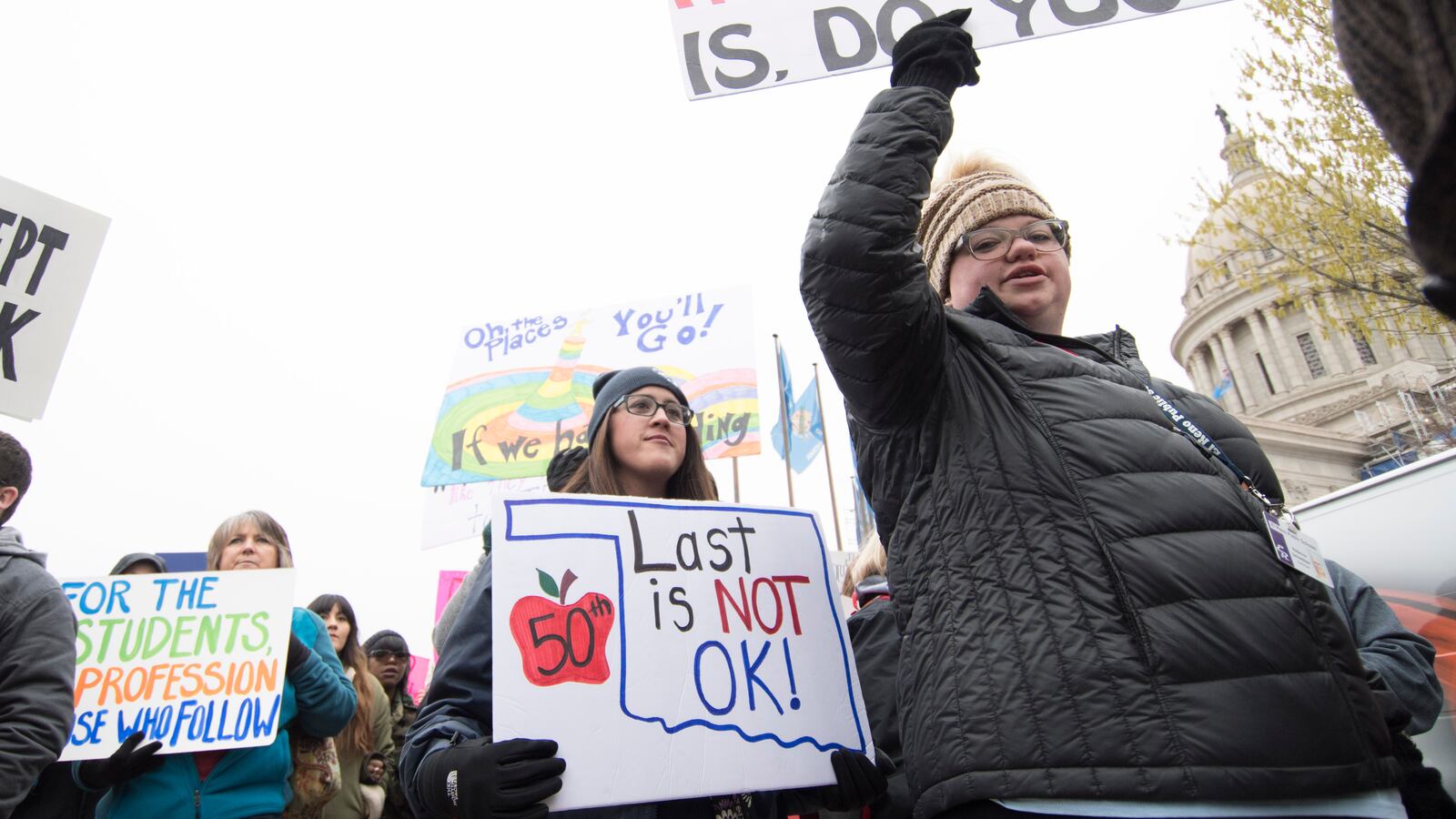It started in West Virginia. Now, Oklahoma teachers are on day two of a walkout that has closed schools across the state. Teachers in Kentucky staged in all-day protest at the state capitol. Arizona teachers are also planning a walkout.
Teachers in states across the country say they’re underpaid and their schools are underfunded. Some have already gotten results: Both West Virginia and Oklahoma teachers have won substantial raises.
And the protesters are making the case that they’re not just fighting for themselves but for their students and state.
“In the long run, we’re hurting Oklahoma when we don’t stand out here and do this,” said one teacher.
The renewed attention to teachers’ paychecks marks a departure from many of the prevailing debates about teacher pay. Those questions, like whether high ratings or student test scores should factor into teacher pay, often focused less on how much to pay teachers and more on how to pay them.
Now, those paychecks are in the spotlight. Here’s a quick guide to the numbers behind the walkouts and how salaries end up mattering for students, too.
Nationally, teacher salary has been stagnant for decades and has been falling behind that of other professionals.
The average American public school teacher earned $58,950 in the 2016–17 school year, according to data from state agencies compiled by the National Education Association and published by the federal government. Adjusting for inflation, that’s about $1,000 less than in 1989 and $3,000 less than in 2009.
Another way to examine teacher pay is to compare educators to similarly educated professionals. (It’s not a perfect apples-to-apples comparison, since people with similar levels of education may have varying skills.)
The Economic Policy Institute, a progressive, union-backed think tank, recently undertook such an analysis. In 1994, teachers’ weekly compensation, including benefits, was about equal to that of similarly educated professionals. But that’s no longer the case. By 2015, teachers nationally earned 11 percent less.
That may not be true for all teachers: High school teachers earned less than other similar workers, but elementary and middle school teachers made more, one study found.
Conservative critics also argue that these sorts of comparisons are flawed because they don’t fully account for teachers’ retirement benefits or tenure protections. They point out that teachers who leave for new jobs often take a pay cut.
Still, there’s no question that teacher salaries haven’t been going up. Why? More recently, in the wake of recession, states made steep budget cuts, and most haven’t fully recovered. Funding advocates argue that some states, including some of those facing teacher protests, just aren’t dedicating enough money to public schools.
Others say the issue is one of priorities, pointing to big increases in non-teaching staff, like aides, custodians, and counselors, and greater teacher retirement costs.

There’s a lot of variation in how much teachers are paid, with particularly low pay in Arizona, Oklahoma, and West Virginia.
Teacher pay varies a lot, ranging from an average of about $42,000 a year in South Dakota to nearly $80,000 in New York.
Another report from the Education Law Center, which supports more school funding, compares early career teachers’ pay (not including benefits) to pay for similarly educated young professionals in the each state. In almost all cases, teachers are paid less.
Teachers in Arizona made 73 percent of similar non-teachers, among the worst in the country. Teachers in Oklahoma (78 percent) and West Virginia (79 percent) didn’t have it much better. Kentucky teachers actually came out ahead of teachers elsewhere, but still lagged behind non-teachers.
Higher pay means teachers are more likely to stay in the classroom. That’s linked to increased student achievement.
The policy argument for paying teachers more is straightforward: you’ll attract and keep better teachers. That’s largely backed up by research.
Several studies have shown that even relatively modest increases in teacher pay can decrease teacher turnover. One recent paper found that a $1,200 bonus in Florida decreased teacher quitting rates from about 17 percent to 11 percent. Bonuses of a few thousand dollars in Denver, North Carolina, and Tennessee had similar effects. One San Francisco study found that an incentive pay program didn’t increase teacher retention, but did seem to attract more effective teachers.
An extensive study in Texas using over a decade and a half of data found that a 10 percent salary increase led to a 1.6 percentage point drop in teacher turnover; the effect was largest among less experienced teachers.
Will students benefit directly from increased teacher pay and the decreased turnover as a result? Probably, though there’s not a great deal of recent research on this.
On average, students seem to benefit when there’s less teacher churn, and that’s particularly because turnover is greatest in high-poverty schools. The Texas study estimates that higher pay means more experienced and effective teachers are more likely to stick around, and that students do slightly better on tests as a result.
Other research has found that when school have more money to spend, including on teachers, students graduate high school at higher rates and earn more money as adults.
“These results suggest that the positive effects are driven, at least in part, by some combination of reductions in class size, having more adults per student in schools, increases in instructional time, and increases in teacher salaries that may help to attract and retain a more highly qualified teaching workforce,” the researchers wrote.
Correction: An earlier version of this story said that Oklahoma, rather than South Dakota, had the lowest average teacher salary in 2016-17. The story has also been updated to clarify the source of teacher salary data published by the federal government.


